What is your favourite dish?
| By boris | 0 Comments

| By boris | 0 Comments

| By boris | 0 Comments

| By Etery | 0 Comments

Interview with Kateryna Lagno (Russia), who drew the regular part of her match with Mariya Muzychuk (Ukraine).
– Kateryna, could you please describe the events of the first two games.
– We have just finished the second game, which turned out to be very long. I guess I had an advantage; not sure how large it was, I will check it at home. Anyway, I was unable to convert it. The first game was very quiet – White did not manage to create serious problems and I equalized the game. Then I offered a draw, and she accepted it.
– Did you manage to surprise your opponent in the opening today?
– Probably, I did. Judging by the time spent, she was a bit surprised. However, she successfully solved her problems.
– What is your mood coming to tie-breaks?
– Business as usual. I have some experience in tie-breaks. Let’s fight and see.
| By press | 0 Comments
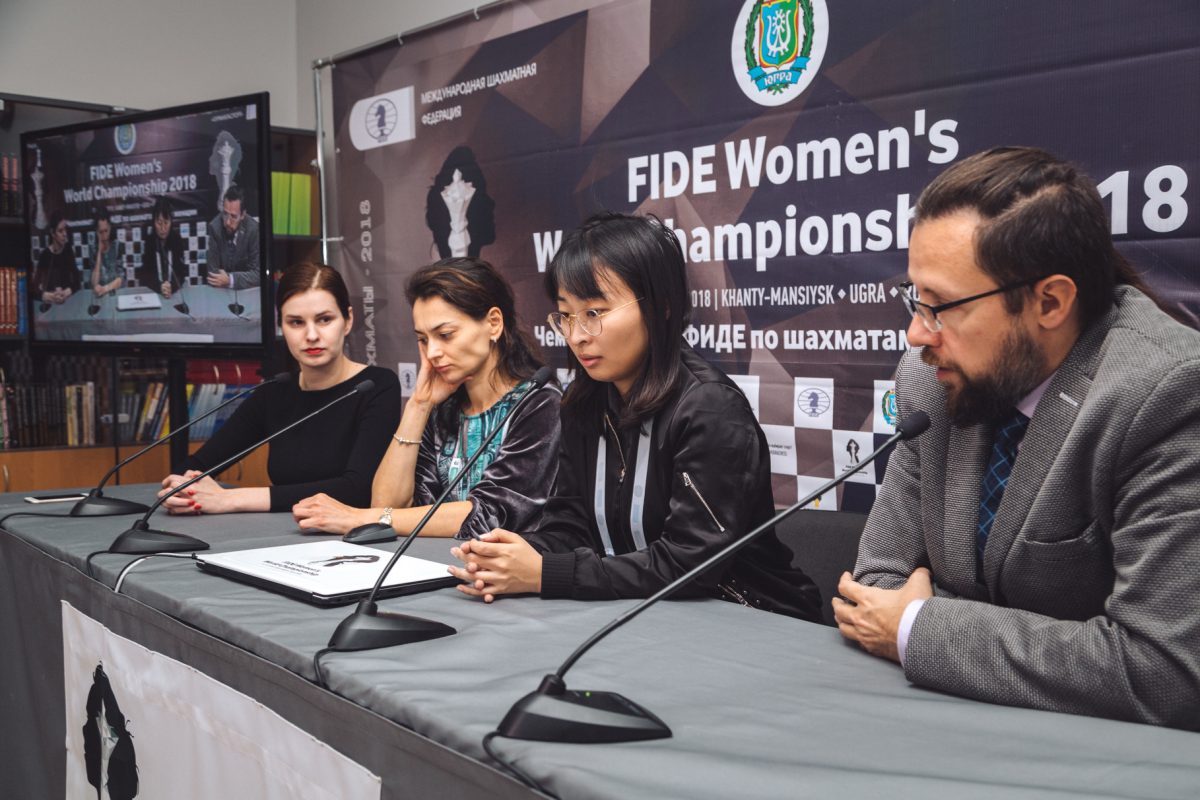
– Ju Wenjun, congratulations on qualifying for the final. Please tell us about the semi-final games with Alexandra Kosteniuk.
– The first game, where I had the black pieces, I played with the idea to avoid Alexandra’s preparation. 18… Nxa6 is a tricky move and after that Black is having a good advantage. Eventually I won the game. I had White in the second game, so it was easier to hold a draw. Alexandra Kosteniuk is a great chess player and she has a very good result against me in the previous games. I was really lucky to win and to qualify for the final.
– Alexandra, what can you say about your performance here? Which match was the best one for you?
– It’s quite difficult to analyze my play right after the tournament. I prefer to have some rest and then I will be analyzing my performance. I had a very difficult pairings and very strong opponents. Naturally, when you get eliminated in the final, it is disappointing but, all in all, I’m quite happy with the result I showed here.
– The same question goes to Ju Wenjun. Are you happy with your performance here so far?
– I’m satisfied with my performance here. I’ve had no play-offs so far and I was able to have a good rest. Actually, this is my first time to qualify for the final and it’s really exciting for me.
– In the final you will either play with Kateryna Lagno from Russia or Mariya Muzychuk from Ukraine. Which player is more, let’s say, convenient for you?
– They are both very strong players. Muzychuk won the Women’s World Championship once and Lagno is a very experienced and talented player. I think both of them will be very difficult to play with.
– Alexandra, we know that the Alexandra Kosteniuk Chess Cup among children is taking place quite soon. Could you tell us a couple of words about it?
– Yes, the Cup starts tomorrow. It’s already the 11th edition of it. It will be taking place in Skolkovo, near Moscow. I will go there, but, unfortunately, I will miss the Opening Ceremony. But still I will visit the tournament and then I will return back to Khanty-Mansiysk to comment on the final.
– Ju Wenjun, you didn’t play a single tie-break during this tournament which means that you had five extra days off. Do you consider it to be a kind of an advantage for you in the coming final?
– I think a good rest with no play-offs helps me play games with classical time control. So far, I think it’s good to have rest.
| By Etery | 0 Comments
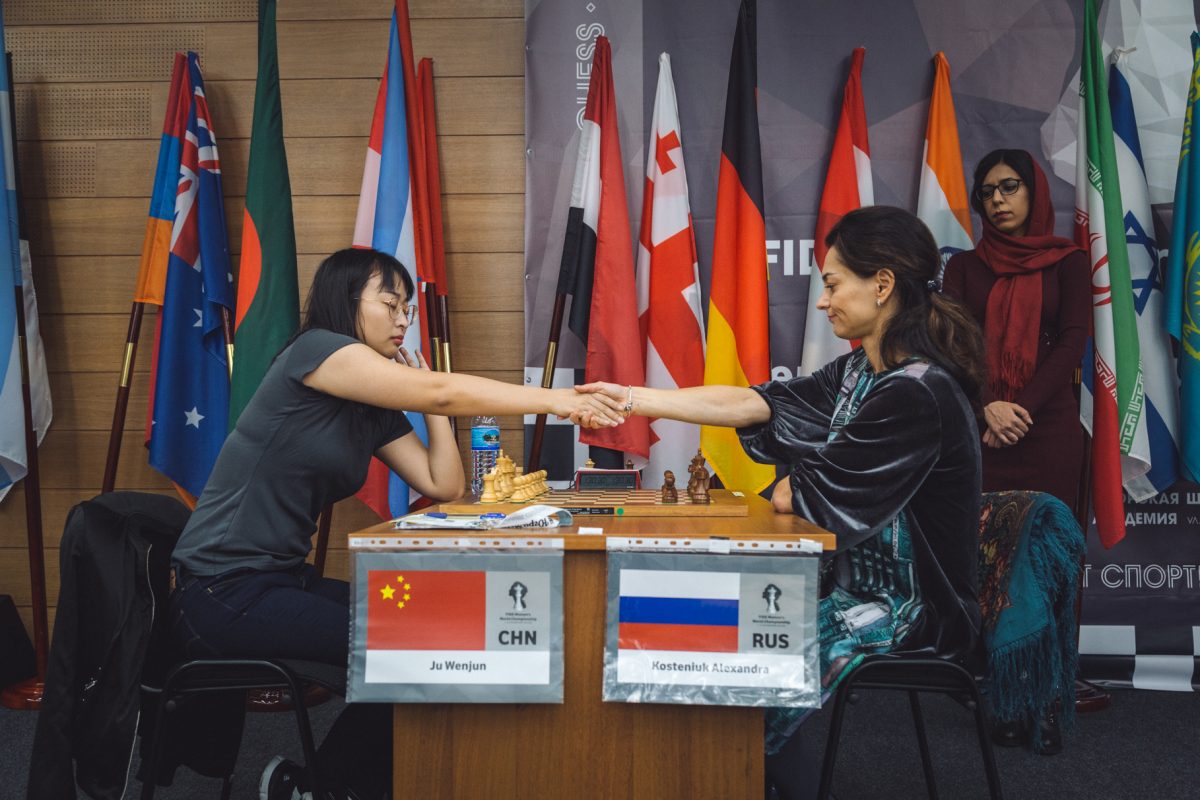
The return games of the Semi-final were played on November 16 in Khanty-Mansiysk.
Ju Wenjun had White against Alexandra Kosteniuk and obtained a stable advantage after the opening. In a Hedgehog position White maneuvered slowly, refraining from any breakthroughs almost until the control move, and even then did not follow it up with more energetic action. Black carried out her break on the queenside, which simplified the position considerably. In the subsequent game, the World Champion did not give her opponent a fighting chance, and the game was drawn in a rook ending.

Ju Wenjun won her match 1.5-0.5 and advanced to the Final.

Kateryna Lagno and Mariya Muzychuk discussed the Open Variation of the Ruy Lopez. Lagno sacrificed a pawn, which seemed to have taken Muzychuk by surprise, as the Ukrainian began to spend a lot of time on her moves. Later White regained material under favorable circumstances, and obtained a pleasant ending with rooks and a bishop. However, the opposite-colored bishops helped Black to hold a draw.
This match will be played out on tie-break tomorrow. Lagno plays White in the first game.
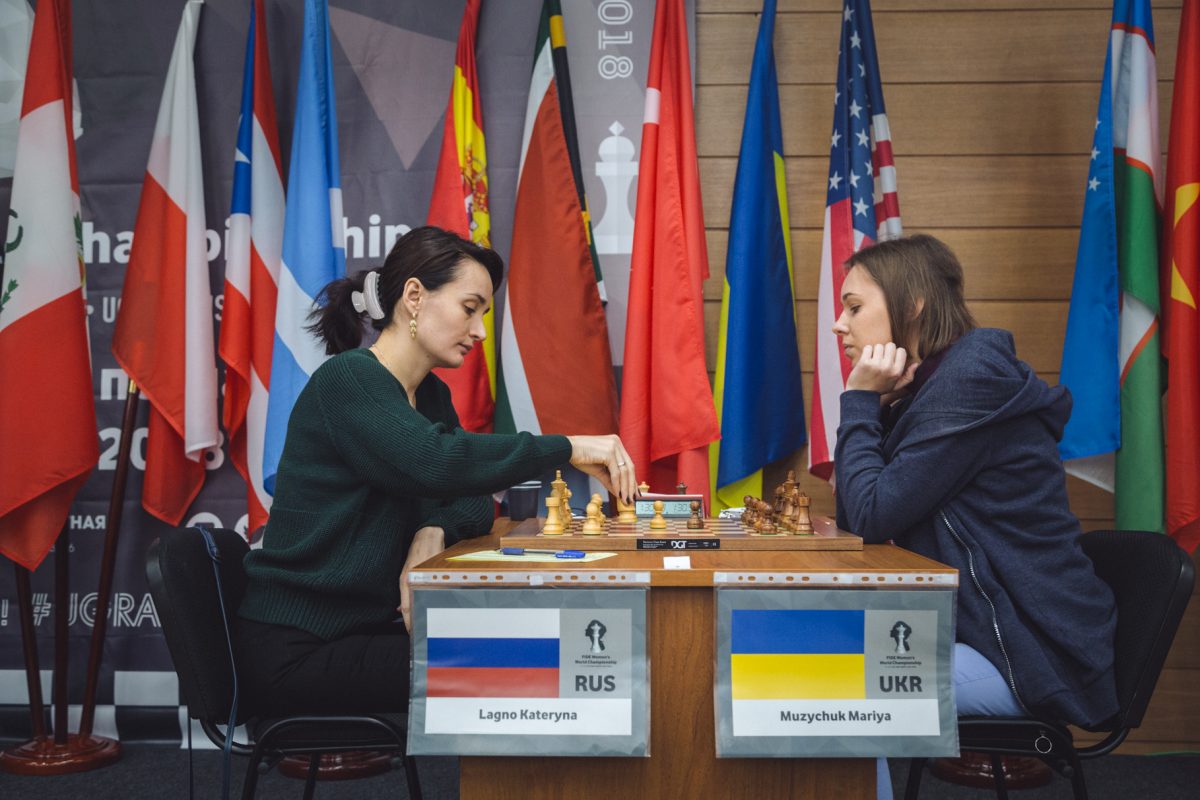
The tie-break will start with two games with rapid time control: 25 minutes plus 10 second per move. If the match is still tied, it will continue with two slow blitz games – 10 minutes plus 10 seconds per move. After that, if the winner is still not determined, two 5+3 blitz games will follow. Finally, those matches that are still tied, will proceed to the Armageddon game.
| By boris | 0 Comments
| By boris | 0 Comments

| By boris | 0 Comments
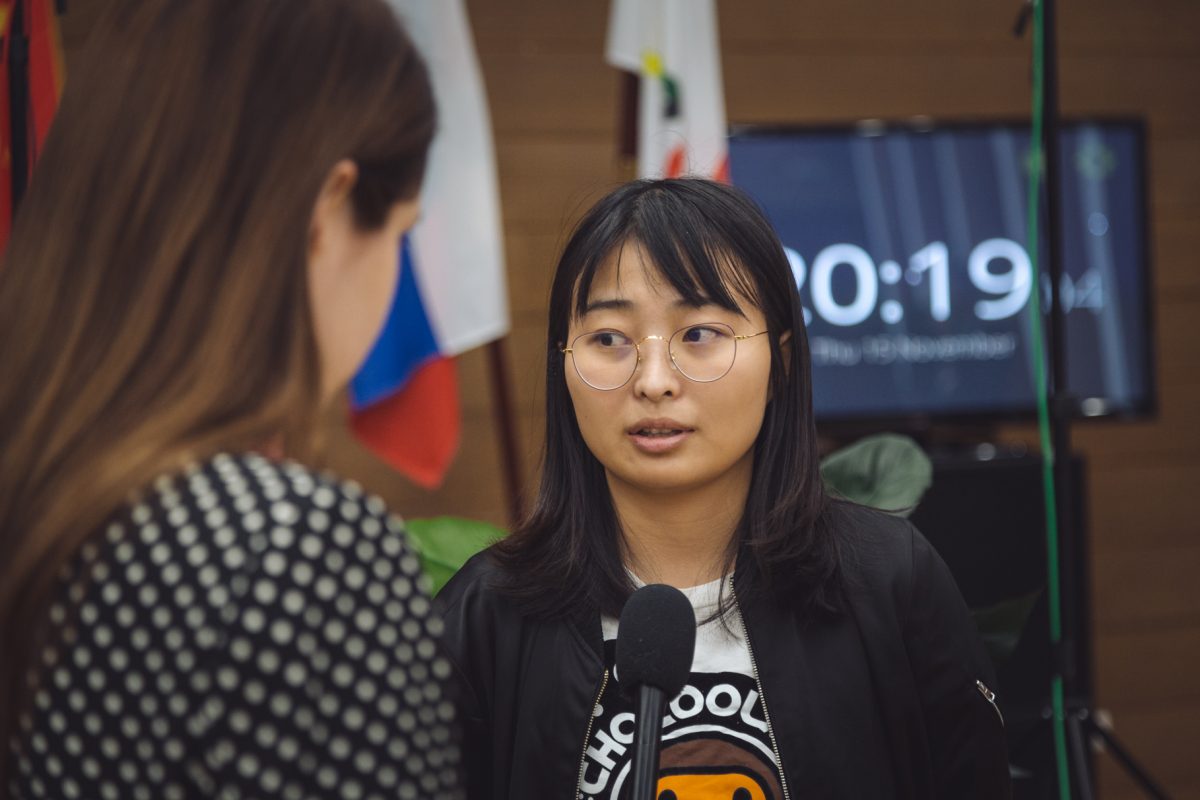
| By Etery | 0 Comments
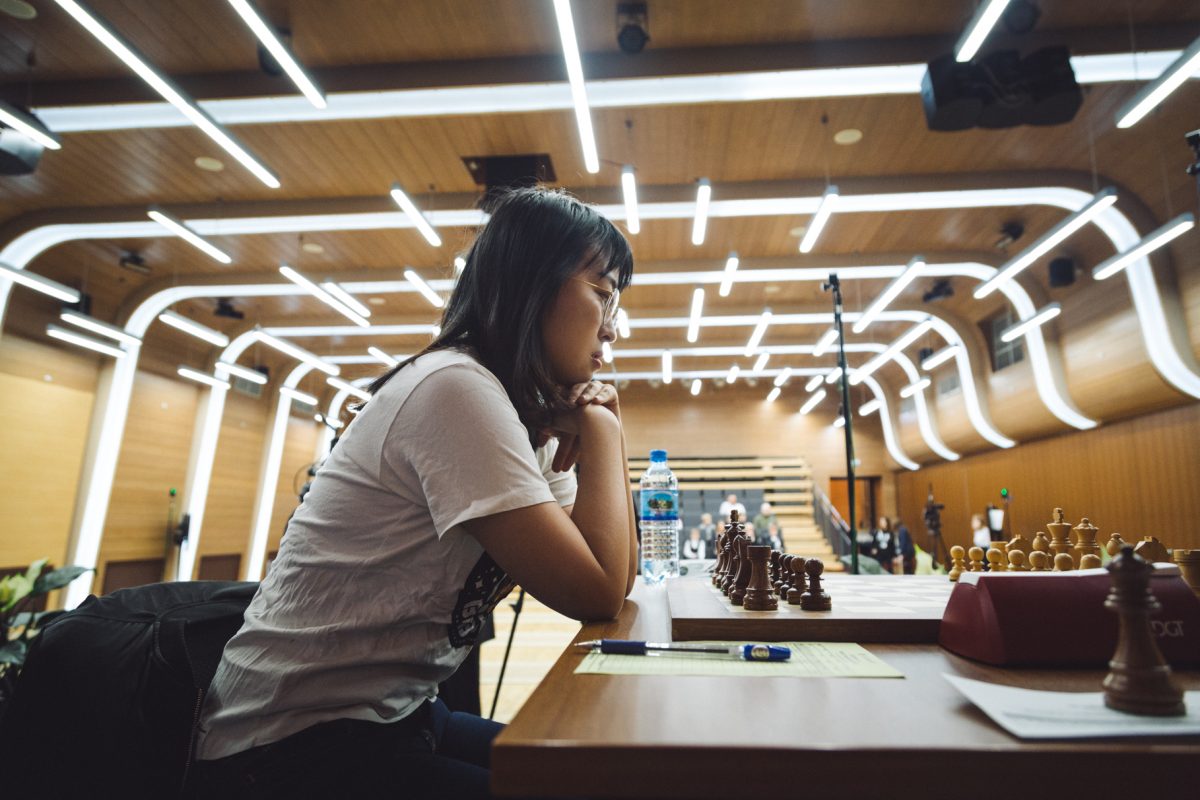
The Semi-final of the Women’s World Championship started in the Ugra Chess Academy.
The defending World Champion Ju Wenjun had Black against Alexandra Kosteniuk. The players went for the French defense. After the opening, White’s position looked promising, as she enjoyed a spatial advantage. However, Black regrouped nicely and won White’s overextended a-pawn. Alexandra did not find the best move at the critical moment, and her position deteriorated quickly. However, then the Chinese missed the strongest continuation, which could give her a decisive edge. Further simplifications followed, but the extra pawn remained and eventually proclaimed itself. Ju Wenjun celebrated victory.
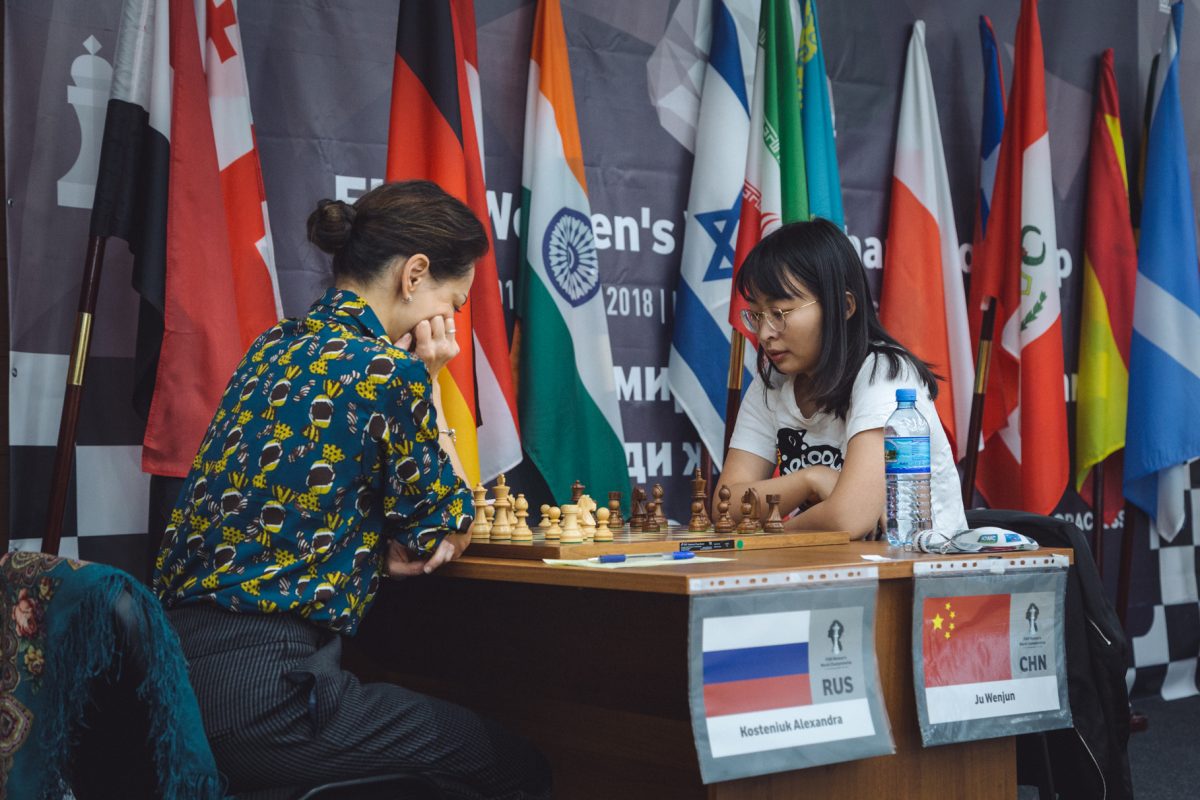
Mariya Muzychuk made a draw with Kateryna Lagno. In the Berlin Variation of the Ruy Lopez neither side could claim any advantage. A draw on the move 23 became a logical conclusion of the game.
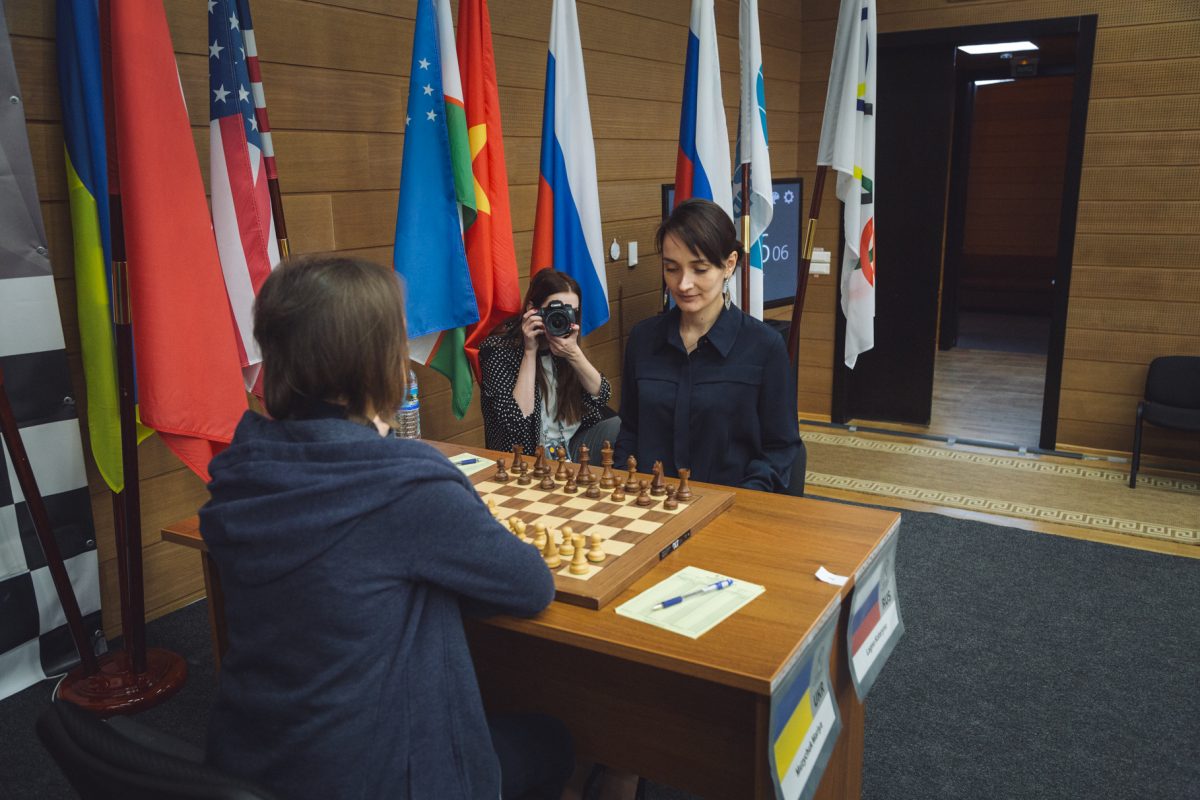
The return games will be played on November 16. If the matches are drawn after two games, the tie-break will ensue on the next day.
| By boris | 0 Comments
| By press | 0 Comments
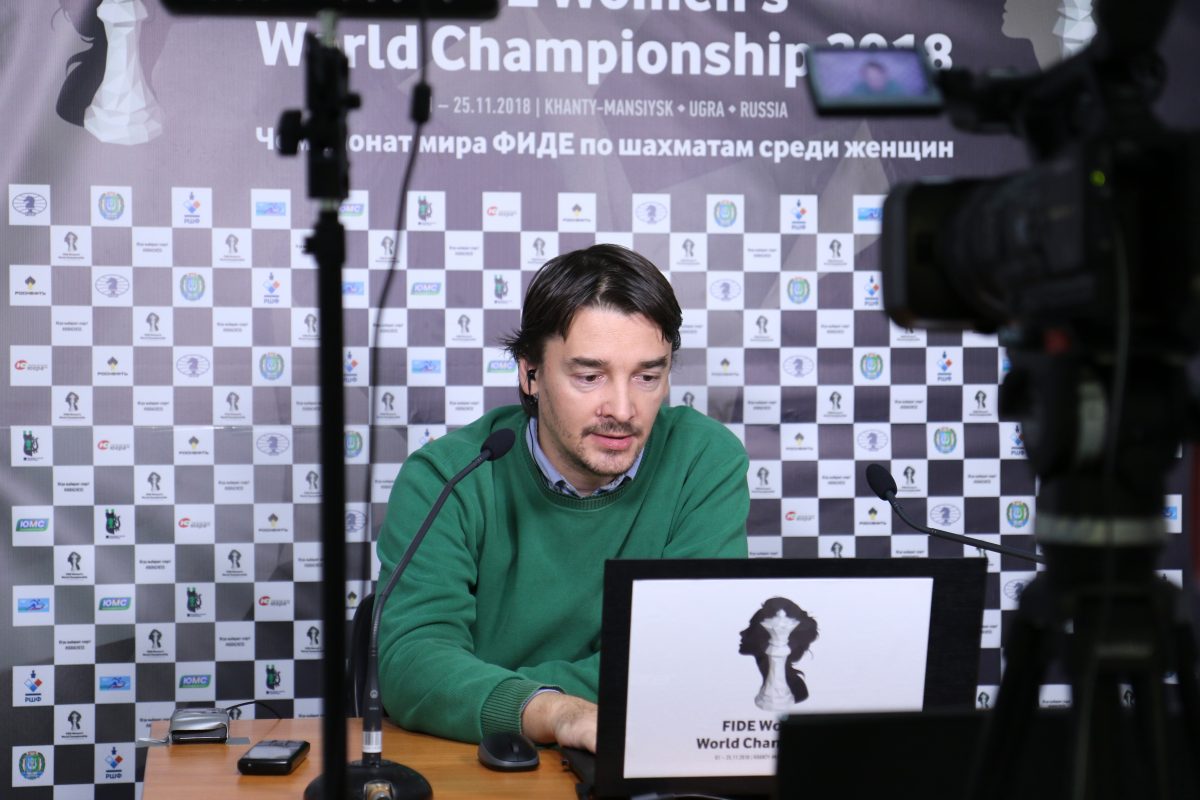
It is not the first time for one of the strongest chess players of his generation to work as a commentator at a major event, and he always approaches this job creatively. Let us find out his opinion on the championship.
– How do you find the World Women’s Championship in Khanty-Mansiysk?
– Quite bleak. November is a fairly cold month in Khanty-Mansiysk. One has to be very careful about the clothing and amount of time spent outside. This is especially important for such a heat-loving plants as yours truly. Some of the participants from the warmer countries are probably uncomfortable here, too. Like it or not, but it brings certain restraints and influences the results.
– Do you like the format of the tournament? Considering this is the last knock-our World Championship…
– This format is exceptionally hard for the participants, however, one cannot invent anything more exciting and attractive for the fans. In my opinion, a knock-out cannot be boring. There is a lot of fight with many decisive games, lack of short draws, and something exciting happens in every round.
The only thing that depresses me is a very small number of spectators. Apart from several officials, fathers, mothers, and other team members, there are very few onlookers. And we are not talking about some open – this is a World Championship! I got used to having no live feedback from my English streams, and this is understandable – all the viewers are on the net. However, I’d like to see more interaction with the Russian commentators.
– Do you have any suggestions?
– I don’t, but I am not an organizer. It is obvious, however, that FIDE needs to do something about it. In my opinion, women’s chess can and must draw more interest than men’s chess. I don’t think the London match between Carlsen and Caruana succeeded in creating much hype, either.

– What would you like to see at the chess events?
– Generally I want to bring excitement back to chess. People must enjoy coming to tournaments. Tournaments can be a good fun, training, or basis for communication, a social circuit of sorts. There is a number of ways to deal with it.
– Back to our tournament – was there anything that surprised you?
– To be honest, I had stopped following women’s chess for quite a while, and wouldn’t know much about the favorites before the championship. As the tournament went on, I caught up with the situation. The games, like in any other women’s tournament, are nerve-wrecking and inconsistent. The same player can play both excellently and horribly.
– A few words about the balance of power.
– The upper part of the table seems stronger than the lower part. The latter has an unquestionable favorite – Kateryna Lagno. She plays much better than anyone else; she is possibly in a good form. I will be surprised not to see her in the final. The situation in the upper part is not as obvious. There is Ju Wenun, Kosteniuk, Anna Muzychuk – each of these players deserves to be in the final.
– Have you discovered any new names?
– Yes, there are some. Judging by purely chess content, I can note the Iranian Mobina Alinasab, who was virtually unknown before the tournament. I liked the girl from Uzbekistan, Gulrukhbegim Tokhirjonova – although it seems everyone else already knew and respected her. I think she has very high potential; she plays solid and powerful chess. It is necessary to mention Zhansaya Abdumalik, whose achievements had reached even my ears. She can achieve a lot in women’s chess, however, if one doesn’t have 2600 by the age of 19, the prospects in men’s chess are nebulous.
– It sounds a little harsh…
– No, I really liked some of her games. For instance, in the middlegame of the first Quarterfinal game against Mariya Muzychuk she played series of moves that a strong grandmaster could be proud of. However, as if often happens with girls, her play is inconsistent. I wish her to keep improving!
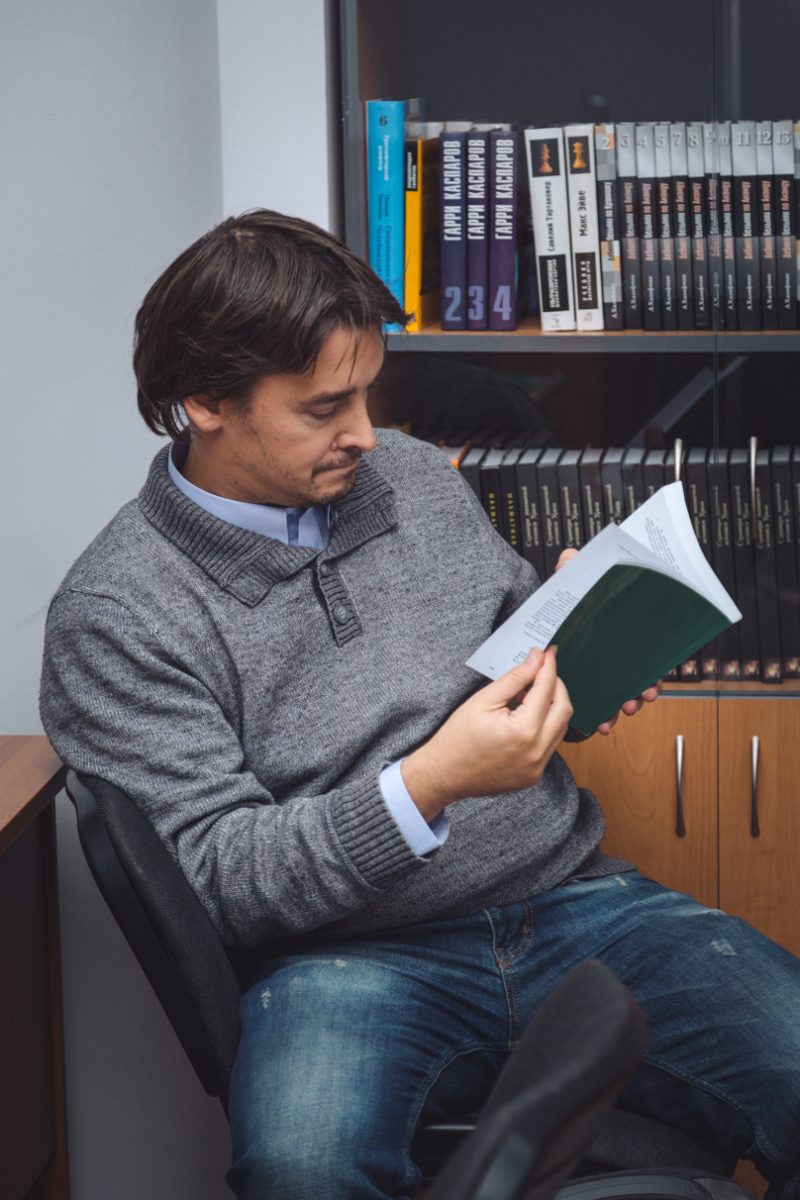
– Do you think the champion can defend her title? It seems she almost meets no resistance…
– That’s it – they aren’t even trying to fight her. Ju Wenjun plays the way she likes, obtains positions she enjoys, she always feels at home. I think she understands very well which strategy can bring her success. This is why her victories look so easy.
– Who can stop her and how?
– I am not sure about who, but I more or less know how. One must play hard against her, take risks, move forward, use bluff…
– You are saying that women’s chess is more attractive than men’s chess. Do you enjoy commenting women’s games?
– As I said, this is a strange job. You have to talk to yourself for five hours straight every day. Perhaps I’ll need a therapist after the championship. I am greatly missing feedback of any sort. Very few spectators come up with questions. I tried to ask them several times, but my own echo was the only response.

| By Etery | 0 Comments
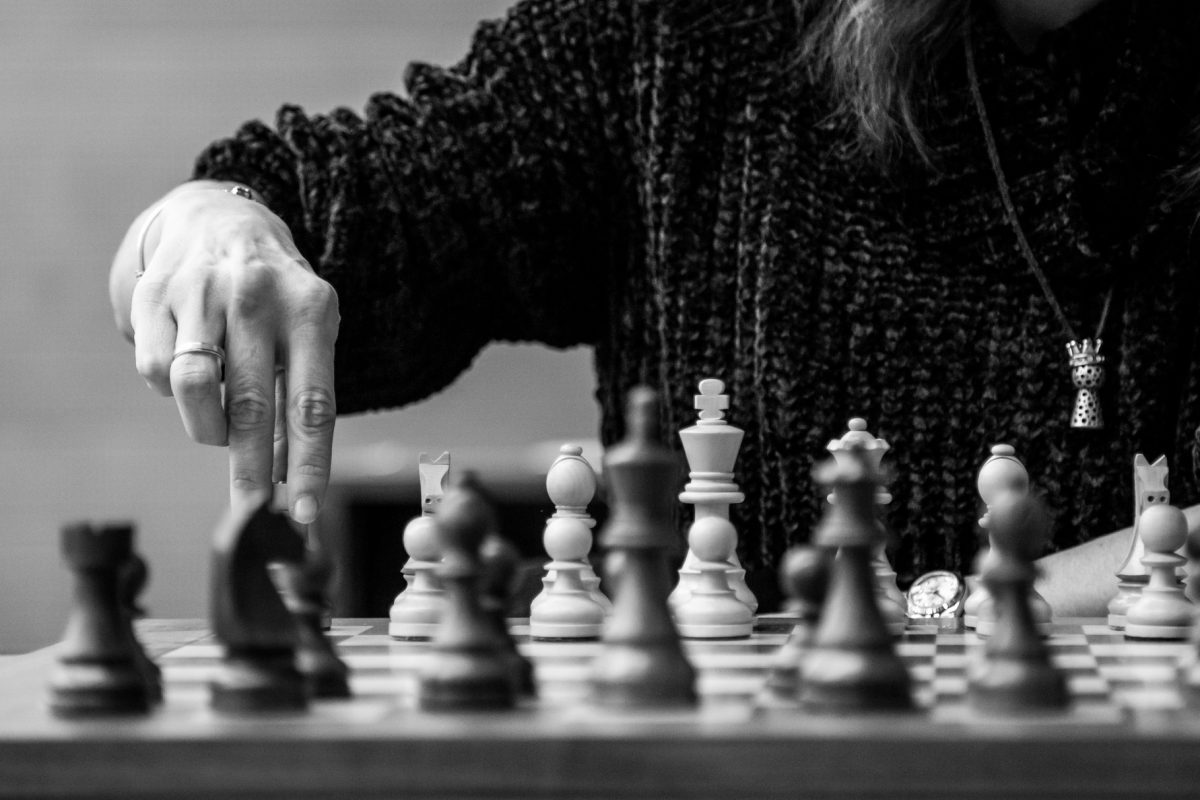
Participants returned to the second round’s pattern: the outcomes of two games were determined in the regular time, while the other two went into tie-breaks. The time for sensations was over – only famous players whose chess strength had long been known, qualified for semi-finals.
The best player of the round was Lagno who had shut out Lei Tingjie. In the first game, the Chinese was unprepared for a rare scheme in the Petroff Defense that Grischuk had recently employed in a couple of his blitz games. She relinquished space and obtained passive position; exchange of the queens served only to add to her problems. The Russian player was building her pressure smoothly, and when her rooks invaded the 7th rank, Black’s position became critical. White’s only inaccuracy on the move 40 allowed her opponent to prolong resistance, but not for long.
In the second game, Lagno played actively during transition from opening to middle game and, by launching her pawn assault on the left area of the board, gained quite a good play. After opening of the center, tactical complications began, where Lei was unable to retain material balance.
Lei Tingjie – K. Lagno
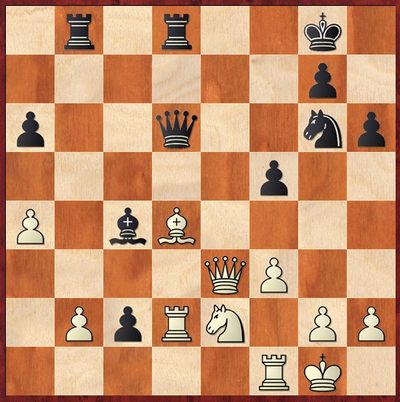
29.Rc1? White cannot play 29.Rxc2 immediately because of 29…Re8 (but not 29…Bxe2 30.Bc5); however, she was able to eliminate that annoying pawn through 29.Bc3!, planning to meet 29…f4 with unexpected retort 30.Qa7!, and Black would have to be distracted with defense of the g7-square.
29…Re8. Stronger is 29…Rb3!, and after 30.Qf2 (if 30.Bc3 Qxd2, then Black is left with an extra knight) 30…Rxb2! 31.Bc3 Qxd2 32.Bxd2 Rxd2 33.Qe1 Rd1 34.Rxd1 cxd1Q 35.Qxd1 Rxe2, pieces are stronger than queen.
30.Ba7. And here White should have changed routes for her queen and bishop! After 30.Qc3 Bxe2 31.Ba7, she regains both the exchange and the c2-pawn with roughly equal chances.
30…Qb4! 31.Qd4. Relatively better is 31.Qc3 Qxc3 32.Nxc3 Rb7 33.Bc5 Bb3 with an unpleasant position despite material equality on the board.
31…Rxe2. Also wins 31…Rbd8 32.Qxd8 Rxd8 33.Rxd8+ Kh7 – both the knight and the b2-pawn hang, and 34.Rxc2 runs into 34…Qe1#.
32.Rxe2 Bxe2 33.Qd5+ Kh7 34.Bxb8.
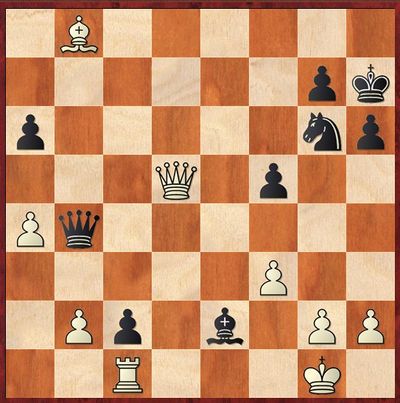
34…Qb6+!Asplendidmaneuver! Every other move throws away the advantage.
35.Kh1 Qe3!?A quicker and more elegant way to finish the matter is 35…Bd1!, and only then Qe3.
36.Bf4. After 36.Rxc2 Bd3!, weakness of the last rank leaves its mark.
36…Qxf4 37.Rxc2 Qxa4! The last touch.
38.Rc1 Qf4 39.Re1 Bb5. Combinational storm calmed down, and Black won easily.
On the second day, it seemed that the reigning Champion of the World would be the first to qualify for semifinals. The day before, Tokhirjonova held out with Black rather confidently; however, while playing with White in the opposite castled position, she gave up the initiative quickly.
G. Tokhirjonova – Ju Wenjun
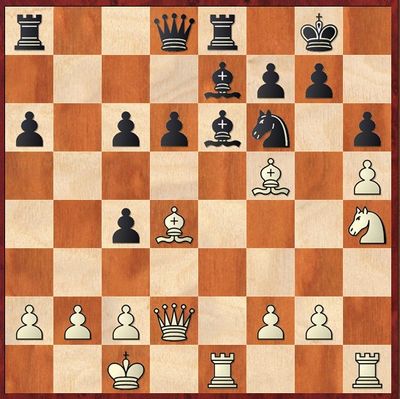
Black is already a pawn up, and her precisely calculated combinational maneuver allows her to magnify her material advantage considerably.
17…Nd5!18.Bxe6, stressing shakiness of the “bishop-on-f5+knight-on-h4” construction. If 18.g3 Bxh4 19.Bxe6 Bg5 20.f4 Rxe6 21.fxg5 Qxg5, then White is two pawns down in a cheerless endgame; 18.Rxe6 would be met with the text thrust.
18…Bg5! 19.f4. After 19.Be3 Nxe3 20.fxe3 Bxh4, both bishop and rook are under fire.
19…Bxf4 20.Bxf7+ Kxf7 21.Ref1 Re1+!A powerful blow, after which some sensitive persons would have resigned on the spot.
22.Rxe1 Bxd2+ 23.Kxd2 Qg5+ 24.Kd1. Now the toughest move was 24…c5, but Ju was late with it, and the inventive Uzbek girl went for complications by sacrificing the bishop that her opponent had neglected to eliminate in time. The World Champion failed to cope with this reversal of the situation immediately and threw away almost all her advantage. However, on the technical stage she was able to “re-win” the game. First, she had gained a knight for her passed pawn, then coordinated her forces by exploiting the opponent’s inaccuracies and managed to keep the only remaining Black pawn alive.
In the regular games, both Kosteniuk and A. Muzychuk demonstrated their excellent opening preparation and made two academic draws.
In the first 25-minute tiebreaker, the discussion in the Chelyabinsk Variation continued. Having obtained a favorable change of the pawn structure, the former Champion of the World got carried away with the idea of an attack on the kingside, and lost coordination of her pieces. Her threats to the king had dwindled away to nothing, and Black’s central passed pawn was more than adequate compensation for the one she had given up. However, at this moment, Muzychuk made two bad moves in a raw, and her main trump was eliminated.
Kosteniuk attempted to benefit from her achievements immediately and gave the opponent a chance to escape.
А. Kosteniuk – A. Muzychuk
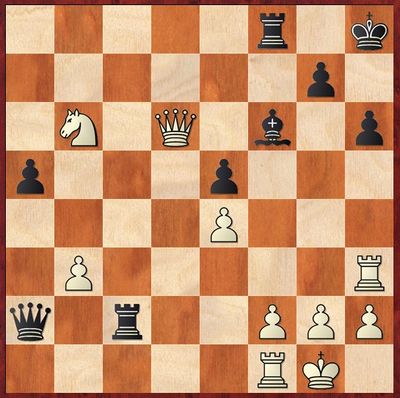
39…Be7! 40.Qxe7 Rcxf2?The previous move would be justified by another capture: 40…Rfxf2! 41.Rxf2 Rxf2. If 42.Rg3, then Black sacrifices her rook to boot and gives perpetual check: 42…Qb1+ 43.Kxf2 Qc2+ 44.Kf3 Qd1+ 45.Ke3 Qxb3+ – the king has nowhere to hide. Attempts at successfully combining offense with defense fail, for example, 42.Qd8+ Kh7 43.Rg3 Rd2, and it is already White who has to force a draw with 44.Rxg7+ Kxg7 45.Qe7+.
And in the game there followed 41.Qxf8+! Rxf8 42.Rxf8+ Kh7 43.Rf1, and Kosteniuk cashed in on her material advantage.
In the return game, her reaction to the Dutch Defense Reversed employed by her Ukrainian opponent was far from perfect, so Kosteniuk found herself in a highly unpleasant situation. Undaunted, the former Champion of the World kept searching for resources to continue the struggle. After mutual inaccuracies, the opponents came to an endgame where White completely dominated in spite of the lack of a pawn. Kosteniuk managed to find the best practical chance: she gave up her knight that kept brooding hopelessly on the edge of the board, and activated the rest of her pieces. Muzychuk lost the thread of the game and parted with both her second-to-last pawn and her hopes for a win. In the ending, the Russian had opportunities to realize her extra pawn but was content with a draw that was her pass to semifinals.
In the duel M. Muzychuk vs. Abdumalik, there were more games played than in all other matches combined.
In the first regular game, the former World Champion emerged from the opening with an initiative but, after Black had sacrificed a pawn for the sake of opening files, she started missing combinational blows.
M. Muzychuk – Z. Abdumalik
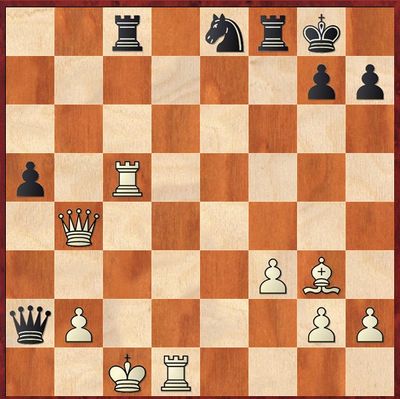
27.Qb5?!The strongest continuation is 27.Qd4 Rxc5+ 28.Qxc5 Qa1+ 29.Kc2 Qa4+, and here the engine still hopes for an advantage after 30.Kd2 Nf6 31.Re1 Rd8+ 32.Ke2, transferring her king from one flank to another under hostile fire.
27…Rf5!Cross-pins always look so captivating!
28.Bf2. The only defense.
28…Qe6 29.Rd3?The only guarantee against material losses is 29.Rd2.
29…Rfxc5+ 30.Bxc5 Qe1+ 31.Kc2. Or 31.Rd1 Qe3+ with similar outcome.
31…Qf2+ 32.Kb3 Qxc5 33.Qxc5 Rxc5, and Abdumalik, who had an extra piece, proceeded to win easily.
The struggle in the second game was also complex, and the Kazakhstani player managed to win the exchange. However, Black’s bishop pair was an adequate compensation for this and, after Abdumalik’s rook got tangled in the enemy back ranks during her attempt to prevent her opponent’s counterplay on the queenside, Muzychuk restored material equality and accurately utilized her positional plusses.
In the first 25-minute game, she again showed both her skill and her self-possession in a complicated endgame. When the crunch came, Abdumalik failed to find an interesting defensive idea.
Z. Abdumalik – M. Muzychuk
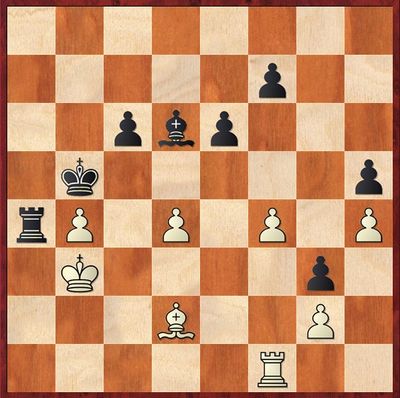
After 48.f5 Bxb4, White was left a pawn down and lost the game. However, after cool-headed 48.Re1!, Black has no improving continuations, and in the variation 48…Bxb4 49.Re5+ c5 50.dxc5 f6!? (both 50…Bxc5 51.Rxc5+ and 50…Bxd2 51.c6+ lead to material losses, while 50…Ra3+ 51.Kb2 does not promise any advantage) 51.Re4! (after 51.Rxh5?, the continuation 51…Bxd2 52.c6+ f5 already works) 51…Ra3+ 52.Kb2 Bxc5 53.Rxe6, the material balance is retained.
Muzychuk was unable to hold her lead. There were many adventures in the game that continued for 90 moves. After the opening, the Ukrainian’s position was dubious, so she opted for a piece sacrifice in order to create pawn center. At the proper moment, Abdumalik carried out an exchange combination and obtained a clear edge with her two pieces for a rook; but later she gave counter-chances to her opponent, and it was already White who had her reasons to play for a win in the endgame with an outside passed pawn. However, Muzychuk allowed the exchange of her main trump, and Black once again turned to be a stronger side in the position with pawns on the same flank. She carried out a carefully prepared advance of her edge pawn and, after White’s error that followed immediately, eliminated the main obstacle on its path to a queening square with her dynamic rook maneuver.
The first 10-minute tiebreaker is sure to make a place for it both in the books on chess curiosities and in textbooks for chess arbiters. The quality of play was high enough with an exception of a mutual slipup in the opening, when an artless attack against black bishop could have run into quite an obvious sacrifice that would leave her with considerable advantage. After long maneuvers typical for hedgehog structures, Abdumalik carried out a breakthrough in the center; however, this allowed Muzychuk to gain a long-lasting edge in the endgame. Eventually, everything boiled down to a theoretically drawn rook-and-knight-versus-rook ending, but tension and tiredness made their presence felt here. Black made a fateful error, and her king got into mating net. It was then that Abdumalik missed her final and rather absurd chance.
M. Muzychuk – Z.Abdumalik
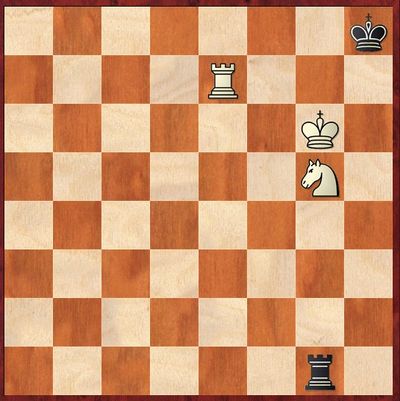
Mate is inevitable, so the Kazakhstani player resigned. However, after 135…Rf1 136.Re8+, there is still no mate on the board but check only, and White’s latest capture has happened on the move 86. Thus, adrawbythe50-moverule!
And even after such a defeat, the younger chessplayer managed to bounce back once again. In the second 10-minute tiebreaker, Muzychuk made a strategic error in the level middle game position, which led to an appearance of a backward pawn in her camp. An attempt at improving this positional defect resulted in a deadly pin on the black rook.
Both players’ nerves were frayed, and in the first blitz game Muzychuk promptly lost a pawn with White; Abdumalik returned the favor by overlooking a standard blow. Black’s king that was stuck in the center found itself in a pretty pickle, and she was left a piece down.
The former Champion of the World obtained a comfortable play with Black and, in spite of her couple of inaccuracies, generally remained in control. In a position was that already clearly better, she first destroyed the enemy king’s cover with her rook sacrifice and then forced a draw that was equal to a victory for her.
| By boris | 0 Comments

| By boris | 0 Comments

An interview with Mariya Muzychuk from Ukraine after her victory over Zhansaya Abdumalik from Kazakhstan:
– Mariya, what happened today in your additional matches?
– It wasn’t easy at all, my opponent fought very well. Two times I won the first game and then couldn’t even make a draw in the second one. I think that the most difficult part was to understand that nothing happened after the lost game and you have the matches to continue so you just had to do your best. I tried to be calm and maybe this helped me.
– The most dramatic game was the first one with “10+10” time control. What was there there?
– Actually I was much better all the game. I won a pawn but at some point I just couldn’t convert it and I was short of time. Then we had a position where I had a rook and a knight against a rook. Of course, I had to play it because there were very many games where the stronger side won.
– But your opponent could have claimed a draw at some point.
– Actually, I am not sure. As for me, it seemed there were no 50 moves. But she didn’t claim, so I won.
| By Etery | 0 Comments
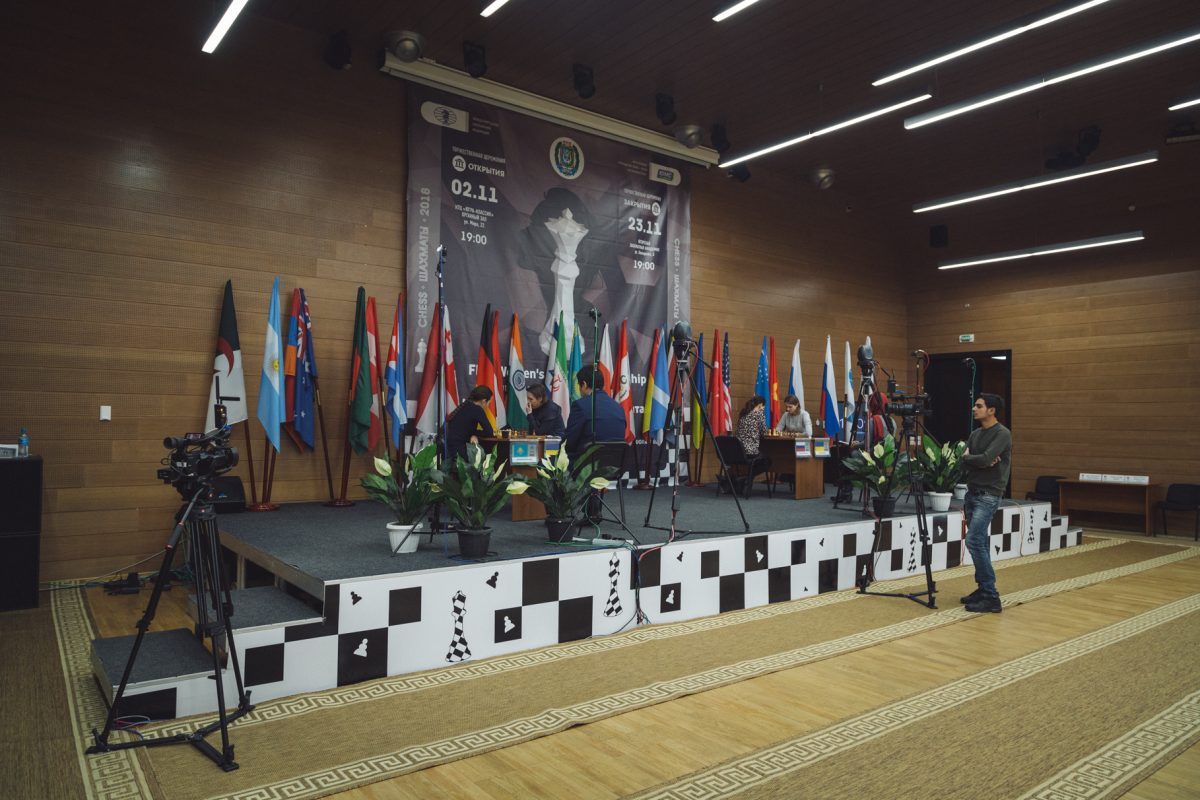
The Quarterfinals of the Women’s World Championship were concluded on November 14 with two tie-breaks: Alexandra Kosteniuk defeated Anna Muzychuk, and Zhansaya Abdumalik lost to Mariya Muzychuk.
Kosteniuk played the first game with White and obtained a promising position after the opening. Then Black managed to activate her pieces and got a strong counterplay. However, being under heavy time pressure, Muzychuk made several mistakes, giving Kosteniuk a decisive advantage.
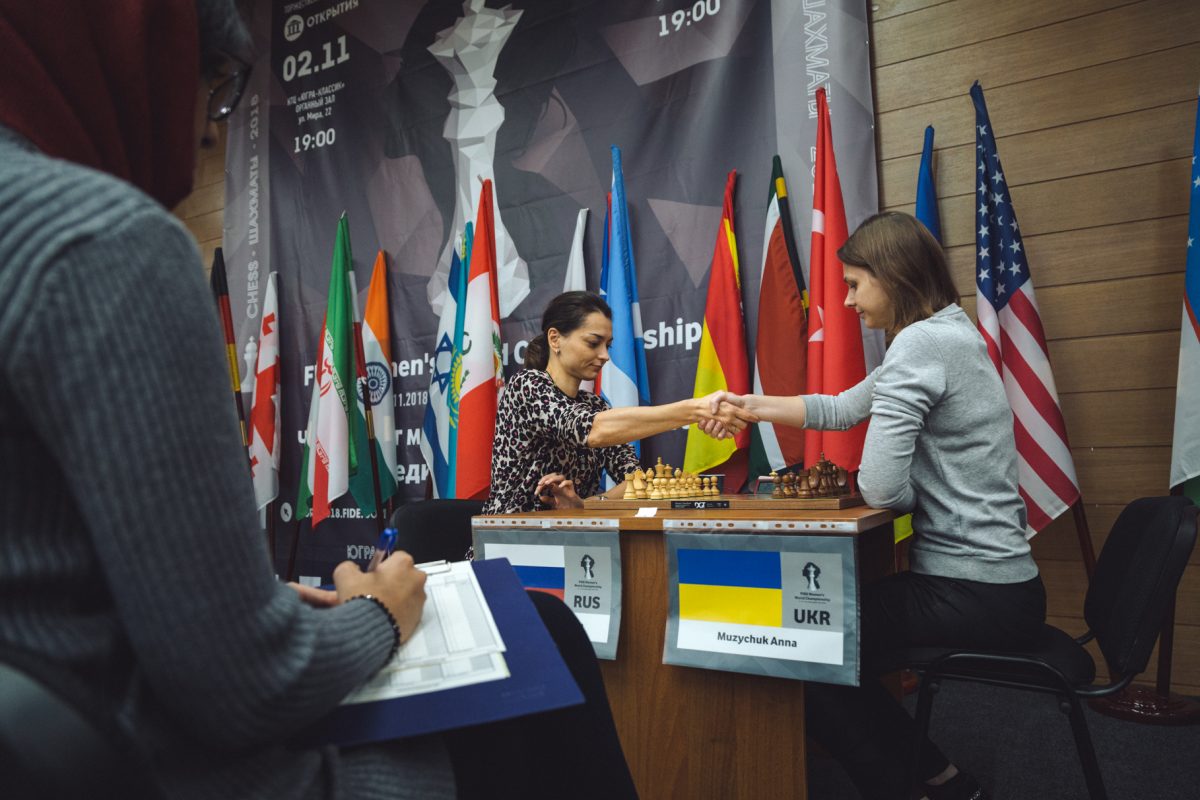
Muzychuk started the second game with 1.f4 and got an overwhelming advantage already in the opening. However, with very tenacious defense Alexandra managed to hold a difficult endgame. Looking for possible winning chances, Muzychuk avoided a number of drawing lines, and Black even got an edge. In the end Kosteniuk secured a draw from the position of strength and advanced to the Semi-final with the overall 1.5-0.5 win.
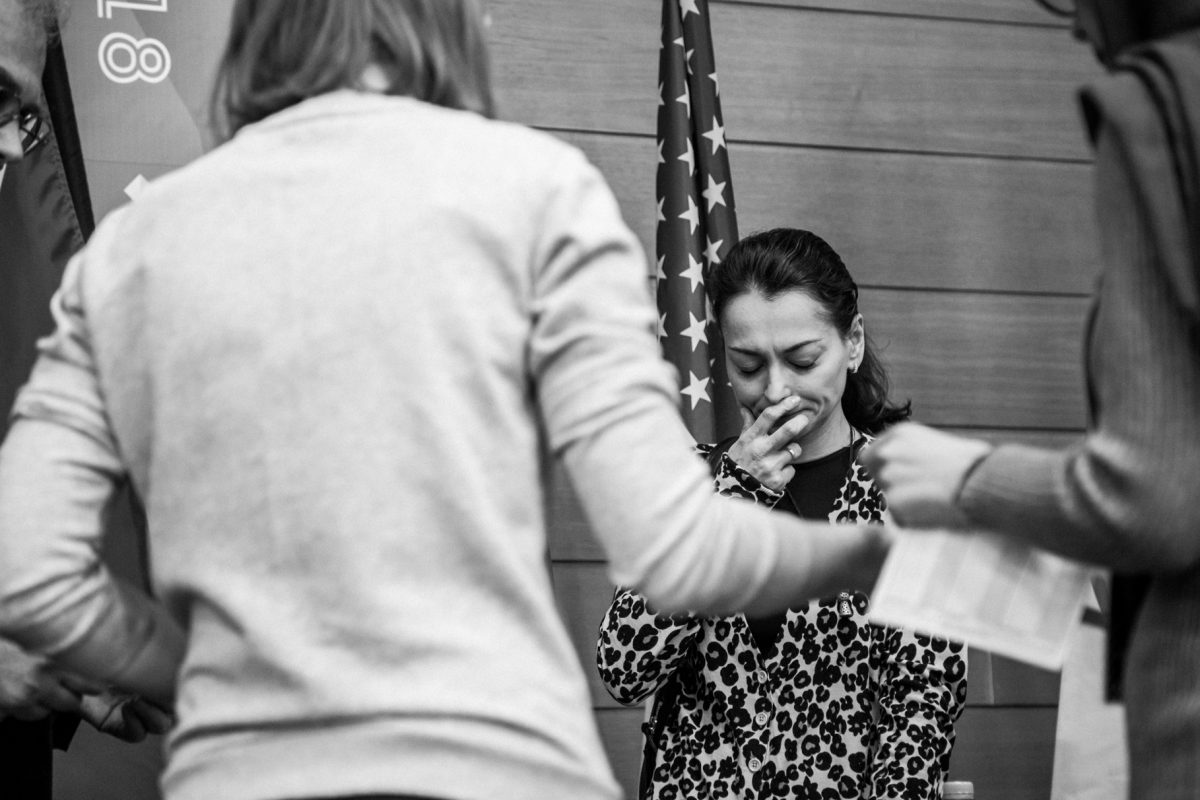
Mariya Muzychuk started the tie-break with a Black victory: Abdumalik failed to convince in the opening and then was gradually outplayed in the endgame. In the return game Abdumalik managed to create a complicated battle. Muzychuk sacrificed a piece, but her compensation proved insufficient. With some adventures in the mutual time trouble Abdumalik converted an extra piece, and the players proceeded to “10+10” stage.
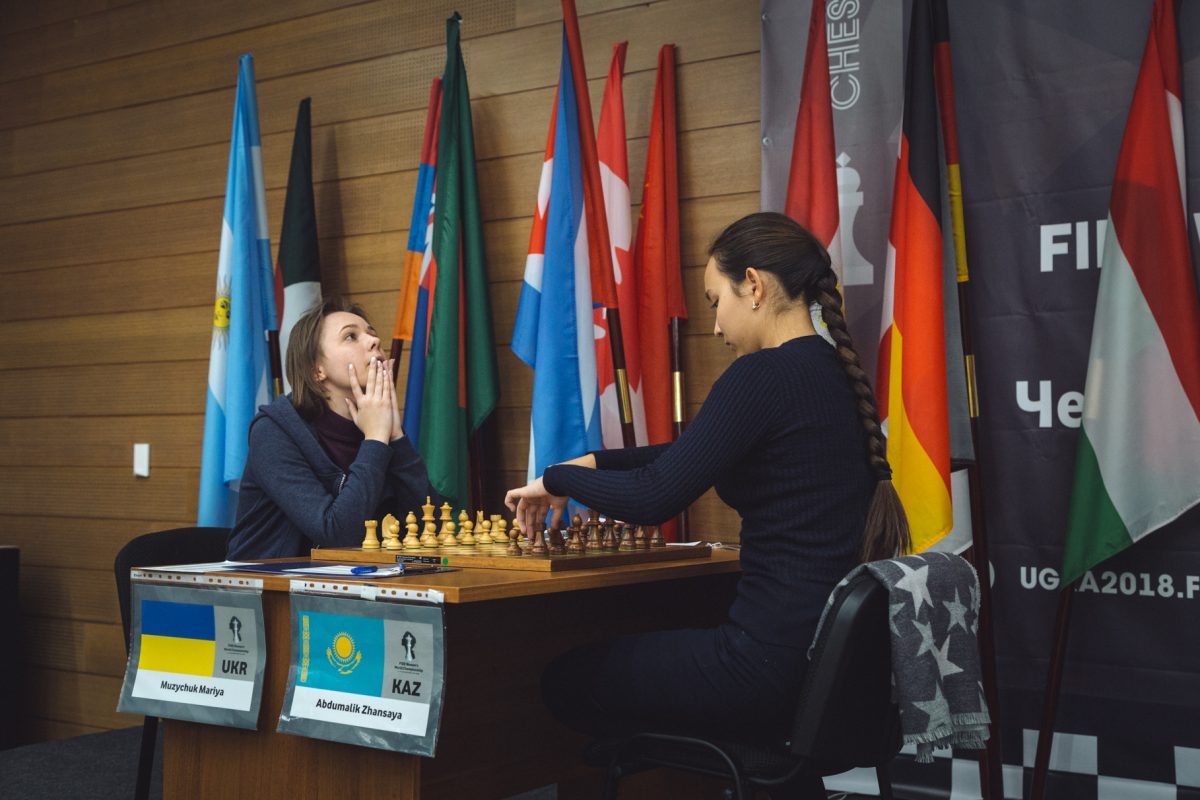
The first 10-minute game was highly dramatic. Zhansaya Abdumalik was defending for the entire game and was very close to a draw. In the endgame R+N vs R she had the right to claim a draw according to the 50-move rule, despite being mated in two moves. However, instead of claiming a draw, Abdumalik resigned.
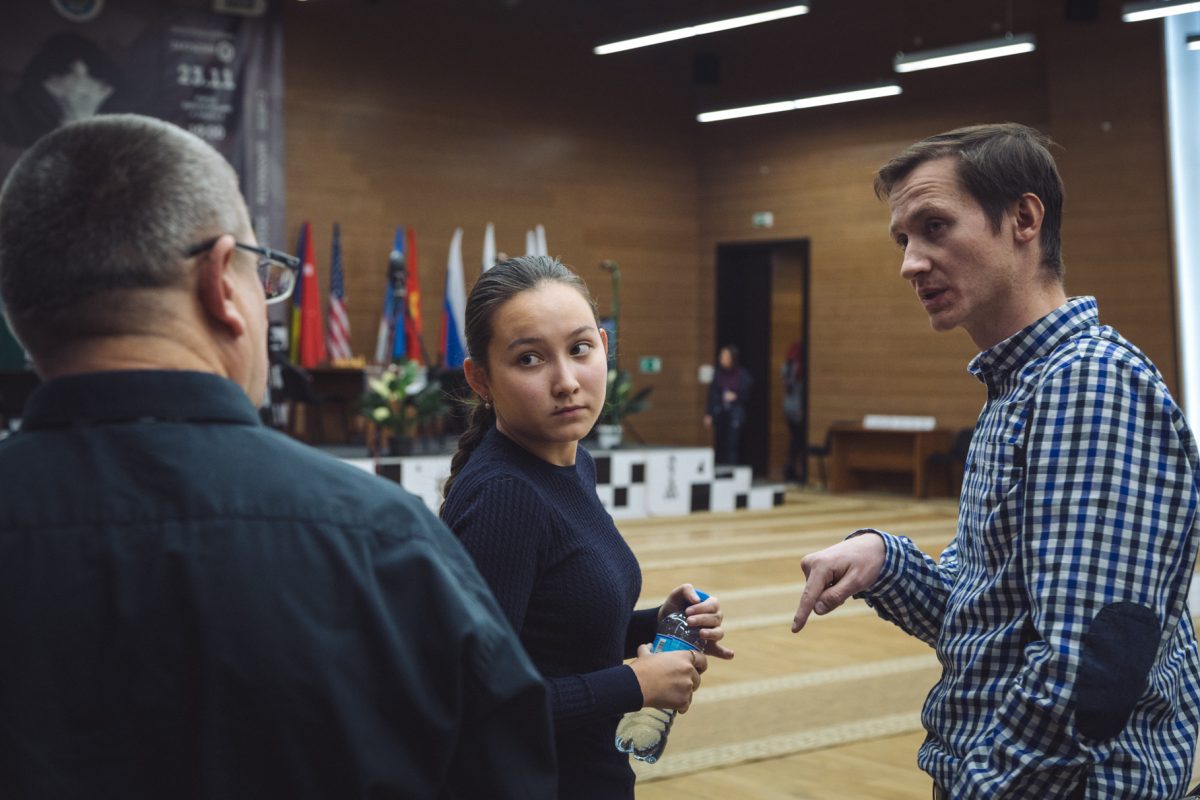
However, Zhansaya demonstrated her fighting spirit and came back in the second game. The match continued by two more blitz games with faster time control.
Mariya Muzychuk won the first 5+3 blitz as White, then got a much better position as Black and forced a draw by perpetual, thus advancing to the next stage.
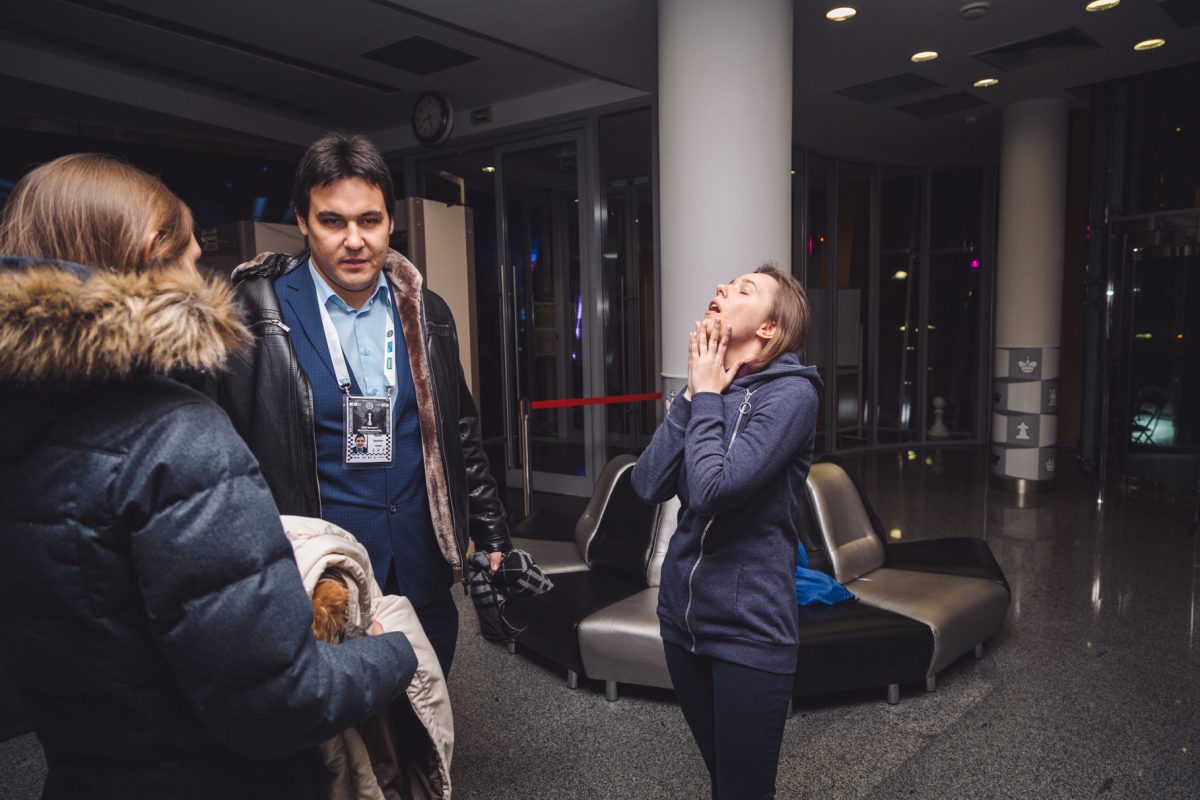
Semi-final pairings:
Alexandra Kosteniuk-Ju Wenjun
Mariya Muzychuk-Kateryna Lagno
All players who had advanced to the Semi-final except for the future champion automatically qualified for the 2019 Women’s Candidates Tournament.
| By press | 0 Comments
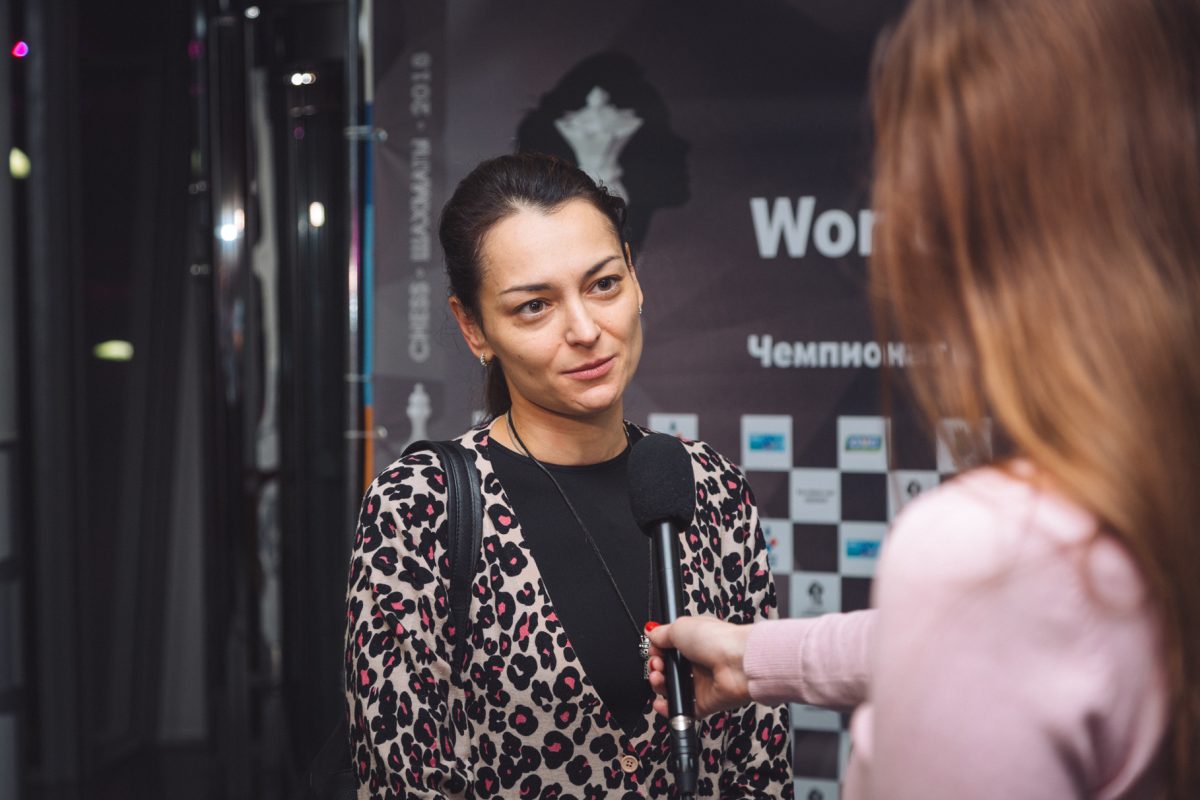
Alexandra Kosteniuk (Russia) defeated Anna Muzychuk (Ukraine) on tie-break of the quarterfinals and advanced to the semi-final of the Women’s World Championship.
– Alexandra, what happened in your games today?
– The second game was a total disaster for me. I missed her idea with d5 and after that I was completely lost throughout the game. But somehow I made a move on one second giving away a knight. But I think that was the best position for me a long time. And then somehow luck was on my side.
– What about the first game?
– The first game was quite logical. At least, the first part of it. I think I got a pleasant position from the opening, and that was the idea to play this line. I mean there was not much advantage but at least it’s easier for White to play it. Then somehow complication started and again I think I was more precise in those complications.
– Since you’ve become a semi-finalist, do you support the idea to make the women’s championship cycle to be like the men’s one?
– I think it will be more logical to have everything similar to the men’s cycle. So you don’t have to explain how things work in the women’s chess. The details can be different but the system should be the same in men’s and women’s events. It will be interesting to see how it goes.
– Did you have any thoughts on qualification for the semi-final before it?
– I knew that I had a good chance to qualify by rating even if I hadn’t qualified but, for example, now Anna qualifies because she is higher rated than me. But usually you prefer not to concentrate on that kind of thoughts. As soon as the game begins you just focus on it.
| By boris | 0 Comments
| By Etery | 0 Comments

Grandmaster Pavel Tregubov is successfully sitting on two chairs in Khanty-Mansiysk: he is both an English broadcast commentator and a coach of her wife Alexandra Kosteniuk. Tregubov is also a professional chess player and the Vice-President of the ACP. We asked his opinion about the championship.
– Were you impressed by the level of play at the championship?
– I do not want to generalize, because the skill level of its participants varies greatly. However, at this stage only the strongest players remain. I am impressed by Ju Wenjun and Anna Muzychuk. Both win their matches easily, on pure skill advantage.
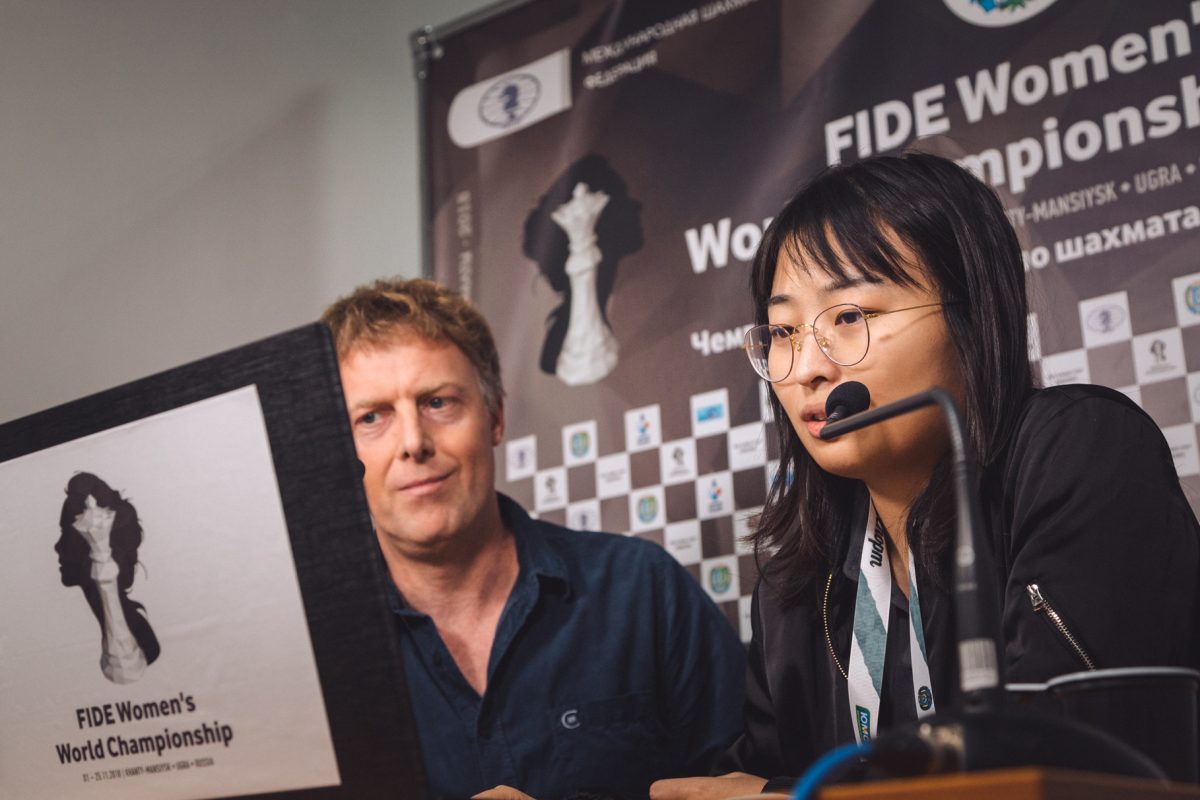
– So, the favorites are meeting your expectations?
– Not all of them. Some were eliminated already, others don’t look as impressive as one could expect. Several strong Chinese players were eliminated early. I don’t think Koneru can be satisfied with her play. Elisabeth Paehtz’s first round elimination was also surprising. Alina Kashlinskaya could clearly hope for more. However, in this format a single blunder can be fatal.
Gunina, Dzagnidze, Harika, Goryachkina went down. Lagno had a very difficult match against Pogonina and barely won it in the sudden death game. Mariya Muzychuk won against Atalik only by a miracle. However, players’ problems only make the spectators happy.
– You saw many knock-out championships. Is this one any different?
– Not especially. One thing is that there are almost no tough tie-breaks here. Everything is decided in either two classical games, or two rapid games, with only one exception.
– Why is that?
– I don’t know. I am reluctant to look for causes that possibly do not exist.

– Is it exciting to watch and comment women chess?
– Well, I get excited easily… There are more mistakes here, of course, but it means more drama. Following these games is more exciting than following men’s elite tournaments. The latter often produce games that look dull for the amateur viewer, who does not understand subtleties and gets bored. Using a football analogy, men often play without shots on goal, something that is impossible in women’s chess.
– Is this good or bad?
– The quality of games suffers, of course, but the plot becomes more exciting. Nobody wants to watch 0-0 draws all the time. And here we have action in each and every game.
– Have you discovered any new names?
– Young Asian players surprised me. I never seen Mobina Alinasab before. Gulrukhbegim Tokhirjonova from Uzbekistan left a very strong impression. She played on the first board at the Olympiad, but I wasn’t following her closely. She plays at a very high level right now. They did not advance that far by a chance – there were no gifts from the opponents.
– You did not mention Abdumalik…
– Zhansaya, despite her tender age, is a well-developed player, and her appearance in the Quarterfinal was hardly surprising. I would also like to mention the young Chinese girls Zhai Mo and Ni Shiqun. They played really well!
– Is there a generational change underway in women’s chess?
– It is a continuous process. However, the most dominating players are the same as before – Ju Wenjun, Muzychuk, Kosteniuk… Yet, the tournament is not finished, let us see what happens next.
Advancing to the Semi-final here is also very important, as three semifinalists qualify for the Women’s Candidates Tournament. There will be no more knock-outs.
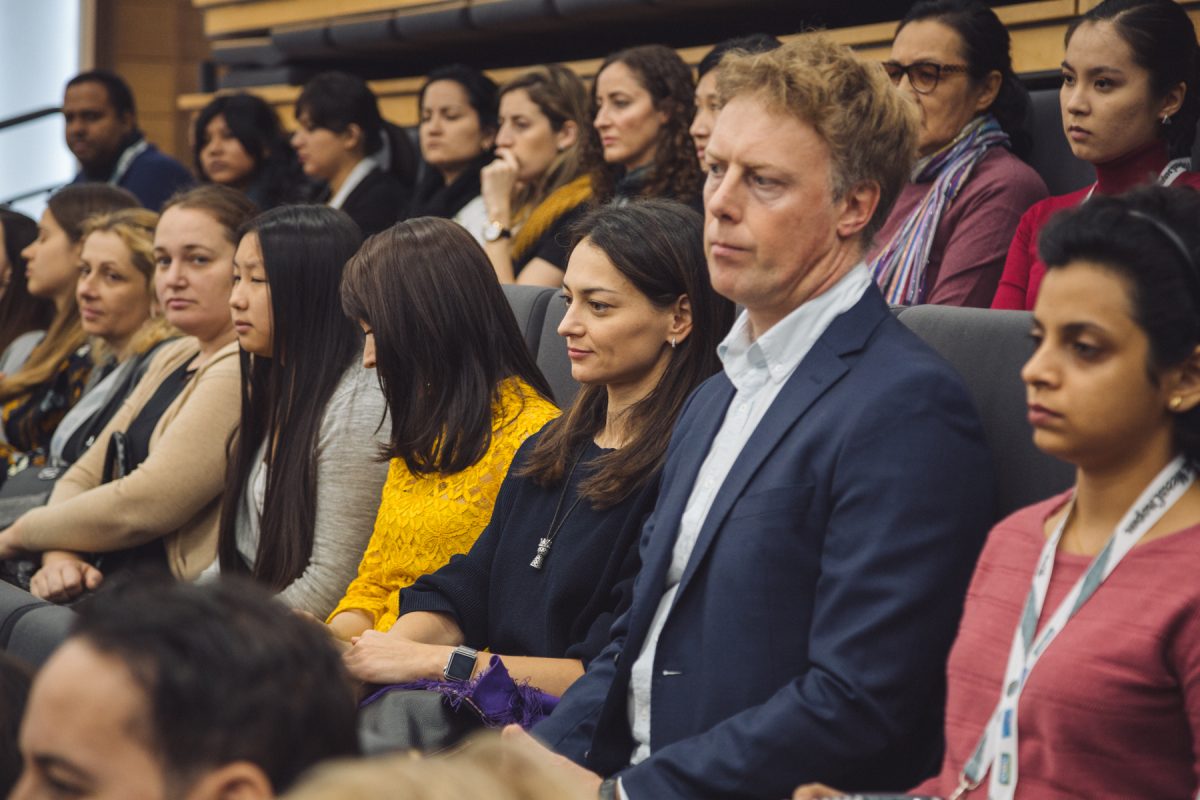
– Does abolishing the knock-out make you sad as a commentator and spectator?
– Yes, a little bit. However, as a professional chess player I know the incredible stress coming from it. There is no room for error in this format. A single blunder – and you’re out.
– It is easier to comment or play yourself?
– No doubt, playing is more fun. I still love playing chess, especially when I play well. Unfortunately, it happens less and less often, but I am still hungry for playing.
Commentary is a different and also quite interesting occupation. However, I don’t have much experience, and commenting alone in foreign language, like I did in the first rounds, is hard. Yet I think I managed to adapt along the way.
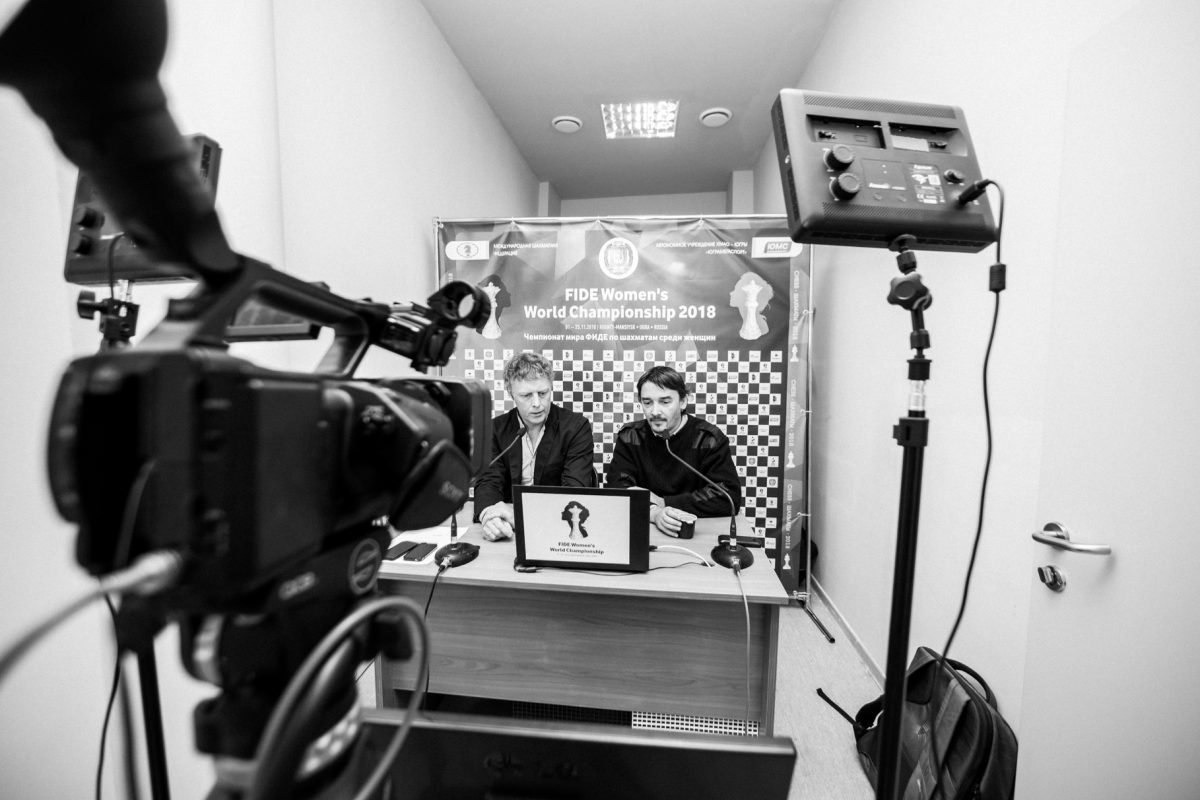
– How do you feel in front of the camera?
– It is a matter of practice. It is not easy to talk to yourself at first, but as soon as you get used to it, it feels perfectly normal.
– How big a part of your commentary is pure analysis?
– It depends. I definitely try to bring more variety to my streams with some stories, etc.
– Do you use engines during the commentary?
– I don’t use computer assistance, it is simply not interesting for me. I think the public prefers to listen to human evaluation. Even when a commentator makes a mistake, it makes a better show than simply announcing the engine verdict. Everybody knows that the computer calculates better than us!

| By press | 0 Comments
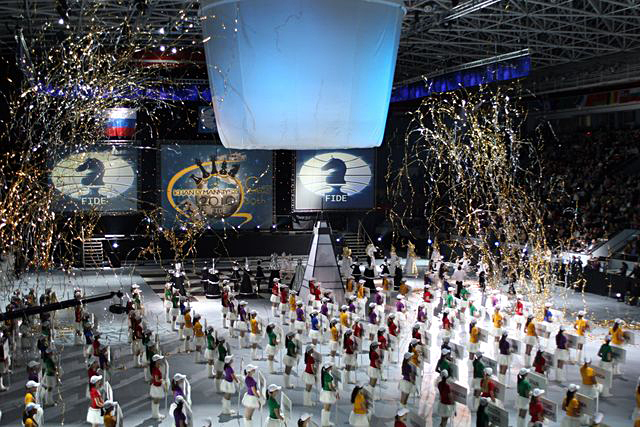
On November 13, a Project Committee meeting under the chairmanship of the Ugra Governor Natalia Komarova was held in Khanty-Mansiysk. It was attended by representatives of municipal units of Ugra in the video conferencing mode.
By the decision of the Committee, the launch of a priority project for the organization and holding of the World Chess Olympiad in Khanty-Mansiysk in 2020 was announced.
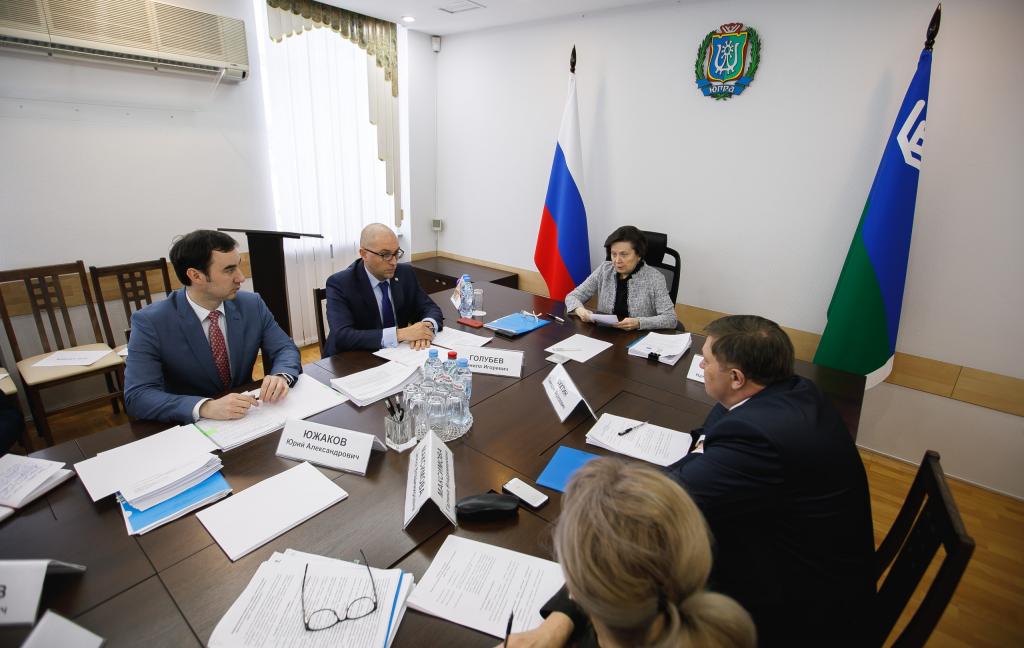
“The goal of the project is to increase the number of people systematically engaged in physical culture and sports by 2024 to 55% of the total population living in Ugra, increasing the competitiveness of the Ugra sports in the Russian and international sports arenas, increasing the competitiveness of the region as a host of the largest world sport events, as well as popularization of physical culture and sports among various segments of population,” said the director of the Department of physical culture and sports of Ugra Sergey Artamonov.
The significance of this project was emphasized by Natalia Komarova: “Ugra, as a region where the Russian and international chess tournaments are held on regular basis, has a lot of trust from FIDE, the Russian Chess Federation, and players themselves. I hope we all understand the importance of our status”.
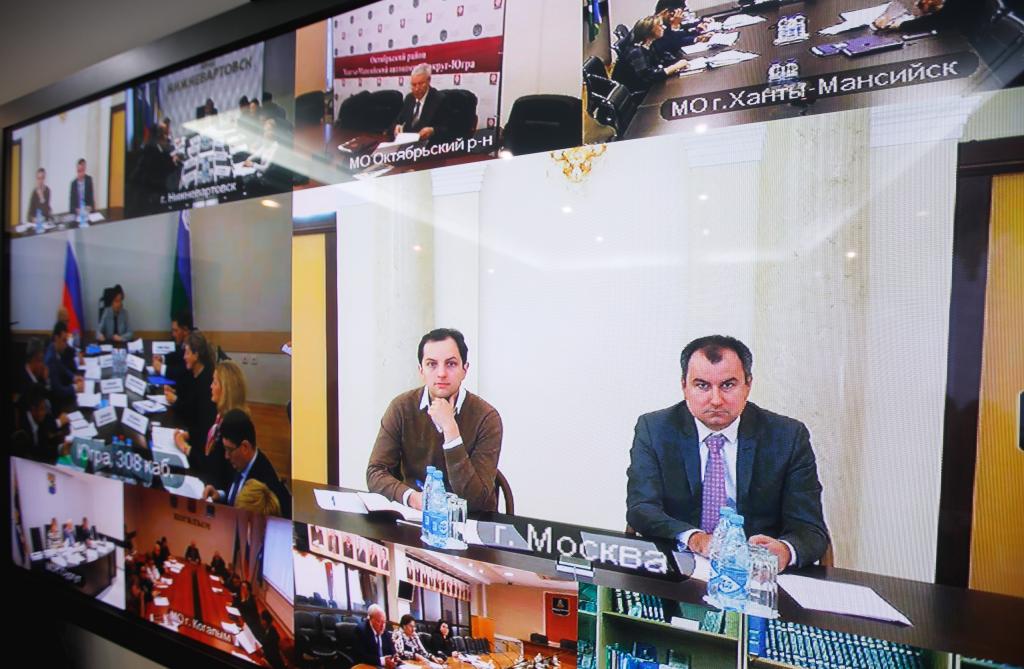
The head of the region also focused on the fact that a new infrastructure would be made, first of all, for the people of Ugra, and will only be used for the Olympiad for the time it will be held.
It is to be reminded that the Chess Olympiad will be held in Khanty-Mansiysk in August 2020. The capital of Ugra will become the fourth city in the entire history of the Olympiad, which will host the largest chess forum on the planet twice. The first time Khanty-Mansiysk hosted the Tournament of Nations was in 2010.

| By boris | 0 Comments

| By press | 0 Comments
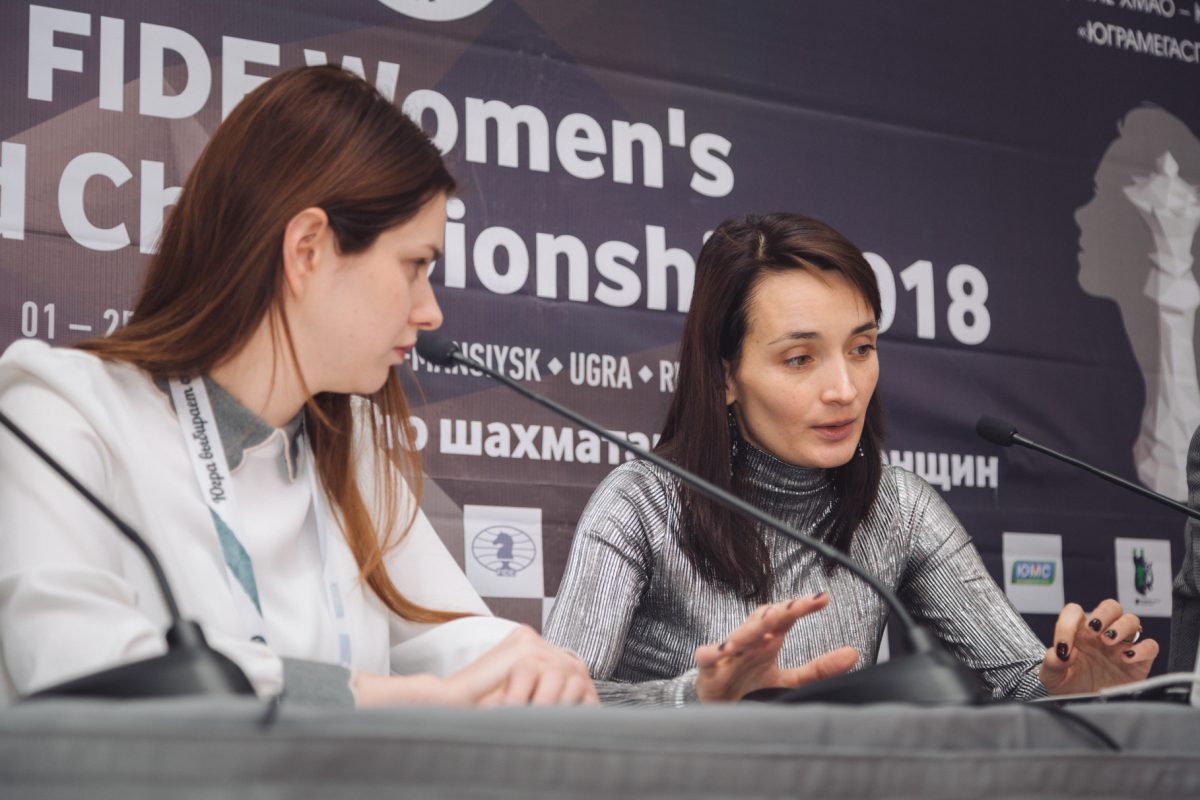
Press conference with the first semi-finalist of the Women’s World Champion Kateryna Lagno (Russia).
– Kateryna, you’re the first semi-finalist. Our congratulations! Please tell us about the key moments of your second game against Lei Tingjie.
– Thank you. She played the line I didn’t prepare at all. It was a very complicated game, at least, for me. She played quickly and I started to think what to do. And I thought that I should play in a solid way, because a draw was OK for me.
– What was your strategy before the game after winning the first one?
– I wanted just to play a normal game and normal chess trying to find the best moves. At least I tried to do it.
– Which match has been the toughest one for you so far?
– Take a guess, please (laughs).
– With Natalija?
– Bingo! Of course when you play Armageddon it’s a bit stressful let’s say.
– Does playing against your teammate make any difference to you?
– I felt really pity for Natalija because I like her very much, she is a nice person. When you win a match in classical or even rapid chess it’s one thing, but when you win a match in Armageddon, of course, that’s another story, you feel pity for your rival.
– As I said before you’ve become the first semi-finalist. Do you support this idea to change the WWCC circle and to make it like the men’s one holding the Candidates Tournament and then the Match?
– Let’s finish this event first and then we will talk about it.
– In semi-final, you will either have Zhansaya Abdumalik or Mariya Muzychuk as an opponent. Which opponent is more preferable for you?
– I don’t know. I played with Mariya some classical games, at least, and I played only blitz game against Zhansaya, I guess. Mariya is a former world champion and Zhansaya is young and also very dangerous. We’ll see.
– You were taking part in tie-breaks in rounds two and three. Finally you will have a day off tomorrow. What are you going to do?
– I want to sleep well, I want to walk and take a flesh air. Maybe some shopping and reading, but no chess.
Recent Comments